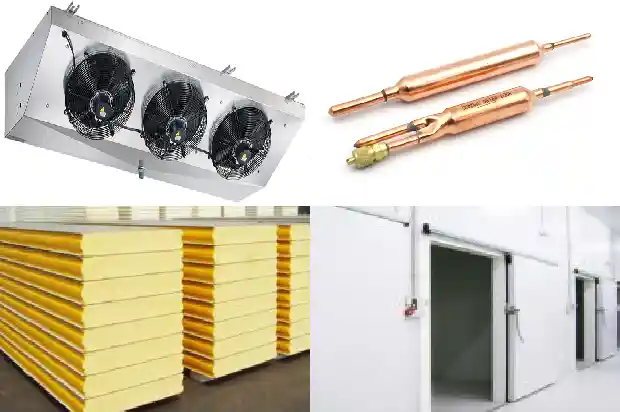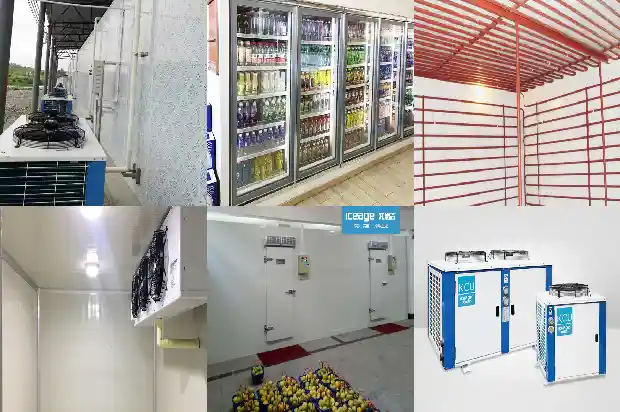Common Faults and Troubleshooting Methods of the Moving Mechanism of Piston Compressors
2024-12-22
01 Impact noise occurs inside the crankcase.
Cause analysis:
Cause analysis:
- Wear and looseness between the big end of the connecting rod and the connecting rod bearing, or the clearance between the connecting rod bearing and the crankpin journal exceeds the allowable tolerance by too large an amount.
- The clearance due to wear between the crosshead pin and the bushing is too large.
- The crosshead pin is loose with respect to the crosshead body.
- The crankshaft bearing runs out of oil or is too tight (the fit clearance is too small) and overheats until it burns out.
- Bolts, nuts of the crankshaft bearing, connecting rod bolts, and crosshead bolts inside the crankcase are loose, stripped, or broken.
Troubleshooting methods:
- Conduct inspection and repair to ensure that the clearance between the big end of the connecting rod and the connecting rod bearing is appropriate. The fit tolerance between the connecting rod bearing and the crankpin journal should be within the specified standard. Those with excessive clearance should be adjusted or replaced.
- During assembly, ensure that the clearance between the crosshead pin and the bushing is within the specified range. For those with excessive wear clearance beyond the tolerance, they should be repaired or replaced.
- Check the cotter pins and lock washers of the crosshead, etc., and assemble them properly to prevent looseness.
- Check the supply of lubricating oil. The fit clearance of the crankshaft bearing should comply with the regulations.
- Check all bolts and nuts of the crankshaft bearing, connecting rod, and crosshead. Tighten the loose ones and replace the stripped ones with new ones.
02 The piston rod overheats.
Cause analysis:
Cause analysis:
- The piston rod is misaligned during assembly with the stuffing box.
- The fit clearance between the piston rod and the stuffing is too small (including that the braided packing cord is stuffed too tightly).
- There is dirt in the lubricating oil for the piston rod and the stuffing or the lubricating oil is insufficient, resulting in dry friction.
- There are foreign objects in the stuffing box.
- The metal disc sealing ring in the stuffing box is stuck and cannot move freely.
- The metal disc sealing ring in the stuffing box is installed incorrectly, the oil passage is blocked, and the lubricating oil cannot be supplied.
- When the stuffing box is assembled to the compressor body, the bolts are tightened unevenly, causing it to be inclined with respect to the piston rod. During operation, the friction between the piston rod and the metal discs in the stuffing increases, resulting in overheating.
Troubleshooting methods:
- Reassemble it without misalignment.
- The piston rod and the stuffing should be assembled with the specified clearance, and the packing cord should be appropriate.
- Ensure sufficient oil supply or replace the lubricating oil and clean the oil dirt.
- Take out the stuffing box, disassemble it and clean it.
- Try it during installation to ensure free movement and maintain a certain clearance as required.
- Disassemble and check to see if there is any incorrect installation. If so, correct it.
- Recheck the stuffing box and correct its inclination.
03 The end covers at both ends of the crankshaft inside the crankcase overheat.
Cause analysis:
Cause analysis:
- The main bearing (tapered ball bearing) of the crankshaft is seized.
- The heating near the end of the motor coupling is because the clearance between the coupling and the motor is too small. When the motor shaft moves axially, it pushes against the compressor crankshaft, and usually the front end of the crankshaft overheats in this case. Conversely, if the clearance between the two couplings is too large, the rear end of the crankshaft will overheat.
Troubleshooting methods:
- Disassemble the crankcase, check the bearings, and replace them with new ball bearings.
- Readjust the clearance between the two couplings to make it meet the specified requirements.
04 The connecting rod bolt is broken.
Cause analysis:
Cause analysis:
- During installation or maintenance, the connecting rod bolts and nuts are tightened too tightly, and the connecting rod bolts are pulled and broken due to excessive tension.
- During installation or maintenance when tightening the connecting rod bolts, misalignment occurs, and the connecting rod bolts are pulled and broken due to uneven load.
- The connecting rod nut is loose (not tightened properly or the cotter pin is broken and pops out), or the connecting rod bearing wobbles inside the big end of the connecting rod. The connecting rod bolt is pulled and broken due to excessive impact force.
- The connecting rod bearing overheats, the piston is stuck, or the compressor operates under overload. The connecting rod bolt is pulled and broken due to excessive stress.


- The connecting rod bolt is worn and suffers from excessive metal fatigue.
Troubleshooting methods:
- During installation or maintenance, when tightening the bolts, the tightness should be appropriate. It is best to use a torque wrench to tighten them (if necessary, use a micrometer caliper or fixed caliper to check their elongation).
- Ensure that the end face of the connecting rod nut closely fits the contact surface on the connecting rod body. If necessary, use the coloring method to check.
- After installation or maintenance, the connecting rod bolts must be tightened tightly and new cotter pins must be inserted to prevent looseness.
- While checking the overheating of the bearing, the piston being stuck or the compressor operating under overload, also check whether the connecting rod bolts are damaged.
- Regularly check whether there are cracks in the bolts. Wash the bolts with oil, soak them in heated oil for 1 hour, carefully wipe them dry, apply soap, and then heat them for a short time. In this way, brown stripes will appear at the crack positions. Or use a magnetic flaw detector to check for internal defects.
05 The connecting rod is broken or bent.
Cause analysis:
Cause analysis:
- The connecting rod bolt is broken or stripped, or is loose, resulting in cylinder knocking and making the connecting rod bear excessive force and bend.
- Because the cotter pin locking the crosshead pin is broken (or the snap ring is stripped), the crosshead pin pops out (or falls off), causing the connecting rod to be bent by impact.
- The crosshead pin is short of oil or the crosshead slide plate and the body guide rail are short of oil.
During movement, the friction is too large (or it seizes), resulting in increased stress, which stretches, breaks or bends the connecting rod.
Troubleshooting methods:
- During installation or maintenance, be sure to tighten the connecting rod nuts according to the technical regulations, carefully check the connecting rod bolts, and lock the cotter pins to prevent cylinder knocking.
- After installation and maintenance, be sure to install the locking snap ring of the crosshead pin properly or insert the cotter pin to prevent the crosshead pin from popping out.
- Be sure to ensure the supply of lubricating oil and not operate with oil shortage. When it is found that the crosshead pin bushing is short of oil and the temperature is high, stop the machine immediately for treatment. Pay attention to check if there are abnormal noises from the crosshead pin and stop the machine immediately for repair.
06 The crankshaft has cracks or is broken.
Cause analysis:
Cause analysis:
- The bearing overheats (due to reasons such as oil shortage and small clearance), causing the Babbit metal on the bearing to melt, making the bearing seize with the crankpin journal or pulling the crankshaft into grooves and causing the crankshaft to bend and deform.
- The bearing is improperly assembled on the crankshaft, resulting in uneven fitting of the supporting surfaces of the crankshaft and the bearing.
- Severe impact, emergency braking or uneven settlement of the foundation can also cause cracks or breakage of the crankshaft.
- The crankshaft has been used for a long time and suffers from excessive fatigue, or the taper and ovality due to wear are too large, resulting in breakage.
- Incorrect installation. When the motor and the compressor are connected by a rigid coupling, if the axial and radial tolerances exceed the regulations, it is easy to cause the crankshaft to bend and break.
- The crankshaft is short of oil or there are impurities in the oil, which burn or pull the shaft into grooves.
- The newly installed crankshaft or crankpin has sand holes and fine cracks that are not discovered in time.
- After the crankshaft is ground or the crankpin is treated, the fillet left is too small, causing stress concentration and resulting in breakage or cracks.
- The clearance of the main bearing at the crankshaft end of the flywheel or the large V-belt pulley is too large, resulting in swinging or wobbling, causing the crankshaft end to bear excessive force and break.
Troubleshooting methods:
- Check the cause of the bearing overheating and do not force its use. Strengthen maintenance to prevent the bearing from being short of oil. When the bearing melts, it must be repaired or replaced with new bearings.
- During operation, when it is found that the flywheel wobbles or the bearing overheats, check whether there are cracks on the crankshaft.
- When such working conditions occur during operation, in addition to checking the cause of this situation, also check whether the crankshaft is damaged.
- For the crankshaft with too serious wear, it should be repaired or replaced with a new one.
- During installation, be sure to meet the technical requirements as required and not allow the tolerance to exceed the regulations.
- Check whether there are impurities in the lubricating oil. Replace the lubricating oil in the crankcase at the specified time to prevent the crankshaft from operating with oil shortage.
- Seriously check the newly replaced crankshaft during maintenance for sand holes, cracks, etc.
- The fillet at the crankshaft and crankpin after grinding should meet the requirements.
- For those with excessive clearance of the main bearing of the crankshaft, repair them in time and do not make do with it.
Related Articles
- Basic Faults and Preventive Maintenance of Water - cooled Units
- Composition and Common Faults of Screw Refrigeration Compressors
- Common Faults and Solutions of Central Air - conditioning Chiller Units
- Common Faults of Industrial Chillers
- Common Faults and Corresponding Solutions of Chillers During Use
- Analysis and Troubleshooting of Common Faults in Air - source Heat Pumps
- Maintenance Methods for Faults in Screw Refrigeration Air - conditioner Compressors
- Analysis of Common Faults in Compressor Overcurrent and Burnout
- What are the reasons for the inactivity of the automotive air conditioning compressor? What are the common faults?
- Common Faults of HVAC Fan Coil Units
- Common Operating Faults and Treatment Methods of Centrifugal Compressors
- Common Four Faults and Replacement Methods of Scroll Compressor
- Analysis of Refrigeration Compressor Motor Faults
- Analysis and Treatment of Common Low-Pressure Faults in Chillers
- Analysis and Treatment of Common Low Pressure Faults in Chillers
- Common faults in refrigeration system (discharge temperature and pressure)
- Common Faults of Screw Compressor
- Top Ten Components of Refrigeration Systems and Five Common Troubleshooting!
